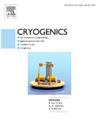硬质弯曲应变对REBCO带载流性能的影响
IF 2.1
3区 工程技术
Q3 PHYSICS, APPLIED
引用次数: 0
摘要
REBCO超导带具有较高的临界温度、较大的工程临界电流密度和较高的临界磁场,这对于20t以上的高场磁体的缠绕是必不可少的。层绕线圈具有诸如较少的接头和减少焦耳加热等优点,但不可避免地涉及硬弯曲,这会产生降低临界电流的应变,并可能在高应变水平下造成不可逆转的损坏。研究了硬质弯曲半径对不同结构REBCO带载流性能的影响。在液氮中进行了临界电流测量,结合理论计算和有限元模拟来表征应变分布。采用分布式光纤技术验证了仿真的准确性。结果表明,应变与硬道弯曲半径呈非线性关系,应变集中在胶带边缘。在硬路弯曲半径为200mm时,镀铜带的临界电流下降到20%,多丝带下降到18%,而不锈钢包覆带保持了70%的临界电流。这些发现为优化层绕线圈的制作提供了理论依据。本文章由计算机程序翻译,如有差异,请以英文原文为准。
Effect of hard-way bending strain on the current-carrying properties of the REBCO tape
REBCO superconducting tapes possess high critical temperature, large engineering critical current density, and high critical magnetic field, making them essential for winding high-field magnets above 20 T. Layer-wound coils offer advantages such as fewer joints and reduced Joule heating but involve inevitable hard-way bending, which induces strain that degrades critical current and can cause irreversible damage at high strain levels. This study investigates the effect of hard-way bending radius on the current-carrying properties of REBCO tapes with different structures. Critical current measurements were conducted in liquid nitrogen, combined with theoretical calculations and finite element simulations to characterize strain distribution. The simulation accuracy was verified by the distributed optical fiber technique. Results reveal a nonlinear relationship between strain and hard-way bending radius, with strain concentrated at the tape edges. At a hard-way bending radius of 200 mm, the critical current of copper-plated tape decreased to 20 %, multi-filament tape to 18 %, while stainless steel-encapsulated tape retained 70 % of its critical current. These findings provide a theoretical basis for optimizing layer-wound coil fabrication.
求助全文
通过发布文献求助,成功后即可免费获取论文全文。
去求助
来源期刊

Cryogenics
物理-热力学
CiteScore
3.80
自引率
9.50%
发文量
0
审稿时长
2.1 months
期刊介绍:
Cryogenics is the world''s leading journal focusing on all aspects of cryoengineering and cryogenics. Papers published in Cryogenics cover a wide variety of subjects in low temperature engineering and research. Among the areas covered are:
- Applications of superconductivity: magnets, electronics, devices
- Superconductors and their properties
- Properties of materials: metals, alloys, composites, polymers, insulations
- New applications of cryogenic technology to processes, devices, machinery
- Refrigeration and liquefaction technology
- Thermodynamics
- Fluid properties and fluid mechanics
- Heat transfer
- Thermometry and measurement science
- Cryogenics in medicine
- Cryoelectronics
 求助内容:
求助内容: 应助结果提醒方式:
应助结果提醒方式:


